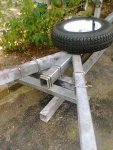minuteman62-64
Lieutenant
- Joined
- Apr 12, 2011
- Messages
- 1,350
Started looking at hitch extenders as a way to get my boat trailer a little further into the water on launching (for easier push off). Did a lot of reading on the pros and cons/safety issues/etc. Decided to give the HF 12" extender w/step a try. Cost $24 for the extender, $18 for a couple of new, longer safety chains and $6 for a 12" wiring harness extension.
Hitch on my Tacoma is a Toyota hitch designed for the Tacoma. Says its good for 5000 lbs tow w/500 lb. tongue weight for the V-6 and 3500 lbs. tow w/150 lb. tongue weight for the 4 cyl (which is what I have). Based on what I've read, cut both specs. in half to determine capacity w/extender. Since my boat/trailer combo is just a little over 1000 lbs. and tongue wt. under 100 lbs. I figured should be OK.
Hooked everything up and tried it out (see photos). On the tow a little, subtle difference. Before, I didn't notice the trailer load at all. W/extender, I could feel the trailer load but no handling issues.
On the launch, worked out great. I can now drop the tailgate for better rearward visibility. Got the trailer deep enough for easy launch/retrieve with rear wheels of truck high and dry.
So far, its a keeper.


Hitch on my Tacoma is a Toyota hitch designed for the Tacoma. Says its good for 5000 lbs tow w/500 lb. tongue weight for the V-6 and 3500 lbs. tow w/150 lb. tongue weight for the 4 cyl (which is what I have). Based on what I've read, cut both specs. in half to determine capacity w/extender. Since my boat/trailer combo is just a little over 1000 lbs. and tongue wt. under 100 lbs. I figured should be OK.
Hooked everything up and tried it out (see photos). On the tow a little, subtle difference. Before, I didn't notice the trailer load at all. W/extender, I could feel the trailer load but no handling issues.
On the launch, worked out great. I can now drop the tailgate for better rearward visibility. Got the trailer deep enough for easy launch/retrieve with rear wheels of truck high and dry.
So far, its a keeper.
























